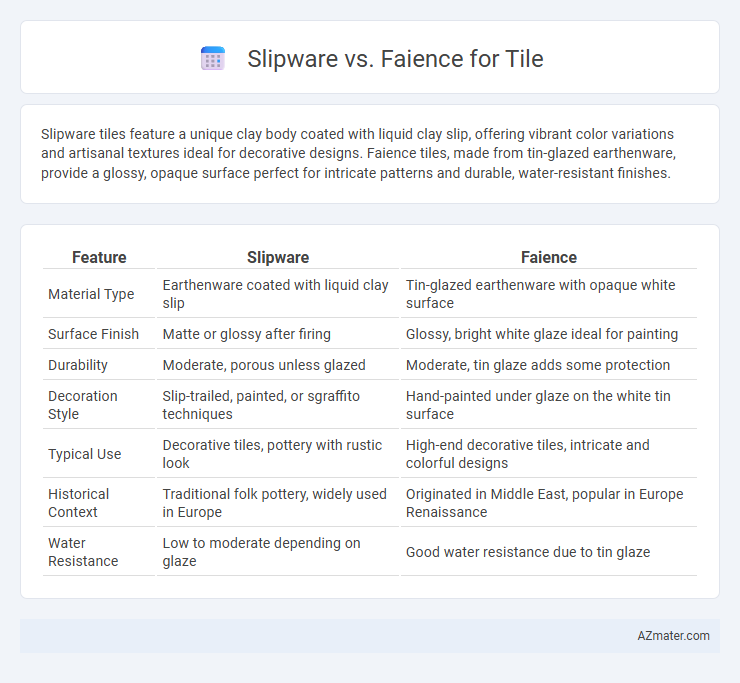Slipware tiles feature a unique clay body coated with liquid clay slip, offering vibrant color variations and artisanal textures ideal for decorative designs. Faience tiles, made from tin-glazed earthenware, provide a glossy, opaque surface perfect for intricate patterns and durable, water-resistant finishes.
Table of Comparison
| Feature | Slipware | Faience |
|---|---|---|
| Material Type | Earthenware coated with liquid clay slip | Tin-glazed earthenware with opaque white surface |
| Surface Finish | Matte or glossy after firing | Glossy, bright white glaze ideal for painting |
| Durability | Moderate, porous unless glazed | Moderate, tin glaze adds some protection |
| Decoration Style | Slip-trailed, painted, or sgraffito techniques | Hand-painted under glaze on the white tin surface |
| Typical Use | Decorative tiles, pottery with rustic look | High-end decorative tiles, intricate and colorful designs |
| Historical Context | Traditional folk pottery, widely used in Europe | Originated in Middle East, popular in Europe Renaissance |
| Water Resistance | Low to moderate depending on glaze | Good water resistance due to tin glaze |
Introduction to Slipware and Faience Tiles
Slipware tiles are crafted by applying a liquid clay slip onto the tile surface, creating unique textures and decorative patterns, often characterized by earthy tones and rustic aesthetics. Faience tiles, originating from tin-glazed earthenware, feature a glossy, brightly colored surface with intricate designs, making them popular in historic and ornate architectural settings. Both types emphasize distinct artistic techniques and cultural heritage, with slipware focusing on tactile effects and faience on vibrant, detailed glazing.
Historical Origins of Slipware and Faience
Slipware originated in the medieval period, primarily in Europe, characterized by the use of liquid clay slip to create intricate surface decorations on pottery and tiles. Faience, with roots in ancient Egypt and later flourishing in the Renaissance, is a tin-glazed earthenware known for its bright, opaque white surface ideal for vibrant painted designs. Both techniques significantly influenced historical tile production, with slipware offering textured designs and faience providing a smooth, colorful canvas.
Material Composition and Clay Types
Slipware tiles are crafted using a base of earthenware clay coated with a liquid clay slip, which contributes to their distinctive textured surface and decorative patterns. Faience tiles are made primarily from fine, white-firing clay with a vitreous glaze, producing a smooth, glossy finish that enhances color vibrancy. The key difference lies in slipware's reliance on colored clay slips for decoration, while faience utilizes a glass-like glaze over white clay for its characteristic sheen and durability.
Decorative Techniques: Slipware vs Faience
Slipware tiles showcase intricate decorative techniques using liquid clay slip applied for patterns, textures, and vibrant colors, often featuring sgraffito or trailing methods. Faience tiles involve tin-glazed earthenware with a smooth, opaque white surface ideal for detailed painted designs beneath a glossy finish, enhancing brightness and durability. Both techniques emphasize artistic expression but differ in material composition and glazing processes, influencing the tile's aesthetic and tactile qualities.
Coloration and Glazing Methods
Slipware tiles exhibit vibrant coloration achieved by applying liquid clay slip, which can be colored with metal oxides, onto the tile body before firing, resulting in rich, textured surfaces. Faience tiles, on the other hand, use tin-glazing techniques that produce a smooth, opaque white base, allowing for detailed painted designs with bright, glossy colors. The glazing method in faience creates a shiny, glass-like finish, while slipware glazing often preserves a more matte or satin surface texture, emphasizing tactile qualities.
Durability and Maintenance Comparison
Slipware tiles, crafted using a liquid clay slip coating, offer moderate durability with a slightly porous surface that may require regular sealing to prevent staining and water absorption. Faience tiles, glazed and fired at high temperatures, provide superior hardness and a non-porous finish, enhancing resistance to scratches, stains, and moisture for easier maintenance. While slipware demands more frequent upkeep to maintain appearance and integrity, faience tiles excel in long-term durability and low maintenance, making them ideal for high-traffic or wet areas.
Applications in Modern Architecture and Design
Slipware tiles offer a highly customizable aesthetic with their fluid, hand-applied slip decoration, making them ideal for artisanal, rustic, or organic-themed modern architecture and interior design schemes. Faience tiles, known for their glazed, often brightly colored surfaces and increased durability, are preferred in contemporary spaces requiring low-maintenance, moisture-resistant finishes, such as kitchens, bathrooms, and commercial installations. Both materials provide unique textural and color possibilities, but slipware excels in artistic expression while faience supports practical, hygienic applications in modern architectural settings.
Regional Styles and Cultural Significance
Slipware tiles, common in English and Dutch regions, feature a decorative technique using liquid clay slip to create intricate patterns reflecting local folk art and historical motifs. Faience tiles, originating from Mediterranean areas such as Italy, France, and Spain, showcase tin-glazed surfaces with vibrant colors and detailed imagery that embody Renaissance and Moorish influences integral to those cultures. Both styles represent distinct regional craftsmanship, with slipware emphasizing earthy textures and cultural heritage, while faience highlights bright, glossy finishes and artistic sophistication.
Cost Differences and Market Availability
Slipware tiles generally cost less than faience tiles due to lower production complexity and simpler glazing processes. Faience tiles, known for their tin-glazed, glossy finish, command higher prices influenced by the artisanal techniques and materials involved. Market availability of slipware tiles is broader, especially in mass-produced settings, whereas faience tiles are often found in niche or specialized markets targeting traditional or decorative applications.
Choosing Between Slipware and Faience for Your Project
Slipware features a porous, iron-rich clay body coated with a liquid slip, offering a rustic, textured finish ideal for traditional or artisanal tile projects. Faience, a tin-glazed earthenware with a smooth, glossy surface and vibrant color palette, suits decorative, high-end installations requiring durability and bright aesthetics. Choose Slipware for a handcrafted, organic feel with muted tones; select Faience to achieve bold, polished visuals with enhanced moisture resistance.

Infographic: Slipware vs Faience for Tile
 azmater.com
azmater.com